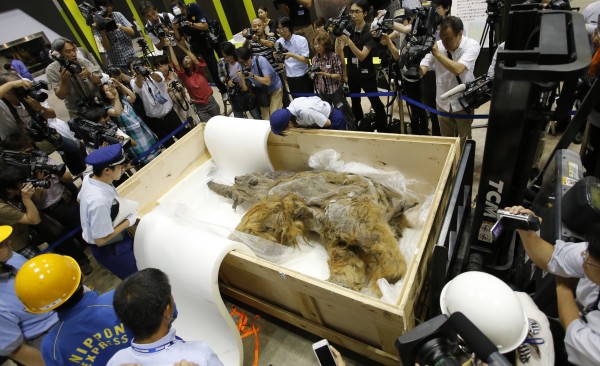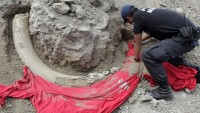Michigan Farmer Accidentally Unearths Remains of Rare Pre-Historic Woolly Mammoth
| Kwao Peppeh | | Oct 03, 2015 06:46 AM EDT |
(Photo : REUTERS/Toru Hanai) People gather around a 39,000-year-old female Woolly mammoth in Tokyo. A farmer in Michigan has uncovered the remains of a woolly mammoth on his soy field in Lima Township.
Paleontologists from the University of Michigan say a local farmer accidentally unearthed the remains of a woolly mammoth which could have been butchered and stored by early humans 15,000 year ago.
James Bristle, the farmer, was digging his soy field in Lima Township on Monday in order to install a drainage pipe when he discovered what he thought was an old fence. After cross-checking, he detected that it was a 3-foot-long bone, which experts later identified as the mammoth's pelvis.
Like Us on Facebook
Bristle contacted experts from the University of Michigan to conduct further investigations into the remains.
Daniel Fisher, a paleontologist and professor at UMich, said him and a team went to the field on Wednesday night and confirmed that the bones were the remains of a prehistoric mammoth. According to Fisher, the mammoth was a rare hybrid between a Columbian mammoth and a woolly mammoth.
He believes that the mammoth, which was around 40 years old when it died, may have roamed the area 11,700 to 15,000 years ago.
On Thursday, paleontologists as well as Bristle's friends and family unearthed twenty percent of the mammoth's remains. These include its skull, tusks, jaws, vertebrae, a pelvis, one kneecap and pieces of a shoulder blade. Researchers postulate that the remains were stored by early humans in a pool which acted as a primitive fridge more than 9,000 years ago.
The mammoth's fore and hind limbs were missing. Paleontologists have theorized that early humans either ate them or buried them at another site. Although researchers don't think early human hunters killed the woolly mammoth, they nonetheless could have eaten and stored its meat. The team found fragments of stone tool and three large boulders near the bones. They postulate that these tools were used as anchors.
"We think that humans were here and may have butchered and stashed the meat so that they could come back later for it," Fisher said.
The team had just one day to unearth the mammoth's remains. Fisher said "We don't just want to pull the bones and tug everything out of the dirt. We want to get the context for how everything was placed at the site."
The remains of the mammoth are currently being stored in a shop on the farm and the pit has since been filled. According to the laws of the United States, the specimens belong to James Bristle, the landowner.
Fisher thanked Bristle for calling on the school when he made the discovery. He added that experts would love to conduct further research on the remains.
"These rare findings are important in enhancing our knowledge of the history and biology of these animals and lifestyle and habits of early humans. Studying this mammoth could also potentially tell us more about the climate system, how it works and what kinds of changes happen over time, which is something very relevant to us right now," Fisher said.
TagsWoolly Mammoth Unearthed Michigan, James Bristle, Woolly Mammoth Remains Soy Farm
©2015 Chinatopix All rights reserved. Do not reproduce without permission
EDITOR'S PICKS
-

Did the Trump administration just announce plans for a trade war with ‘hostile’ China and Russia?
-

US Senate passes Taiwan travel bill slammed by China
-

As Yan Sihong’s family grieves, here are other Chinese students who went missing abroad. Some have never been found
-

Beijing blasts Western critics who ‘smear China’ with the term sharp power
-

China Envoy Seeks to Defuse Tensions With U.S. as a Trade War Brews
-

Singapore's Deputy PM Provides Bitcoin Vote of Confidence Amid China's Blanket Bans
-

China warns investors over risks in overseas virtual currency trading
-

Chinese government most trustworthy: survey
-

Kashima Antlers On Course For Back-To-Back Titles
MOST POPULAR
LATEST NEWS
Zhou Yongkang: China's Former Security Chief Sentenced to Life in Prison

China's former Chief of the Ministry of Public Security, Zhou Yongkang, has been given a life sentence after he was found guilty of abusing his office, bribery and deliberately ... Full Article
TRENDING STORY

China Pork Prices Expected to Stabilize As The Supplies Recover

Elephone P9000 Smartphone is now on Sale on Amazon India

There's a Big Chance Cliffhangers Won't Still Be Resolved When Grey's Anatomy Season 13 Returns

Supreme Court Ruled on Samsung vs Apple Dispute for Patent Infringement

Microsoft Surface Pro 5 Rumors and Release Date: What is the Latest?












